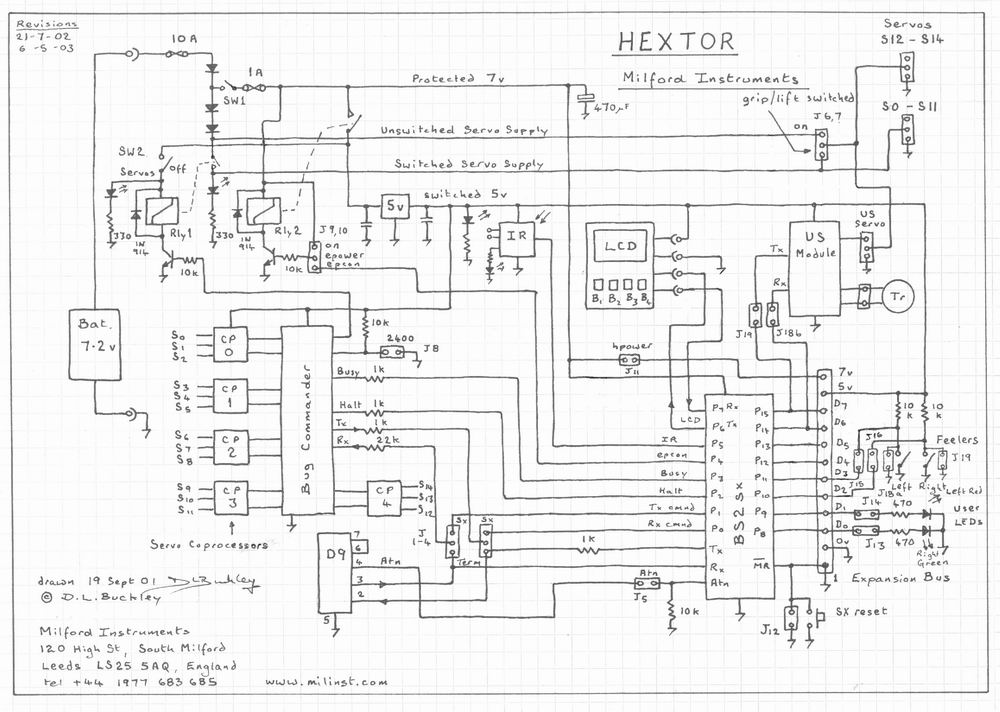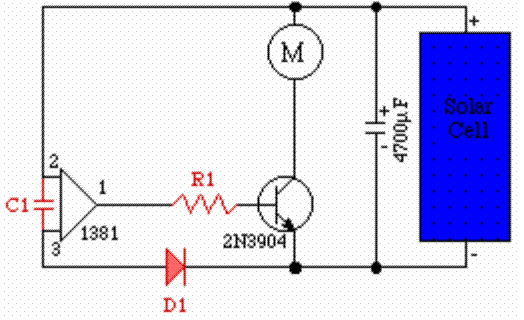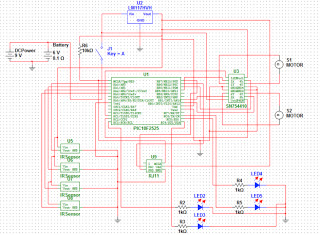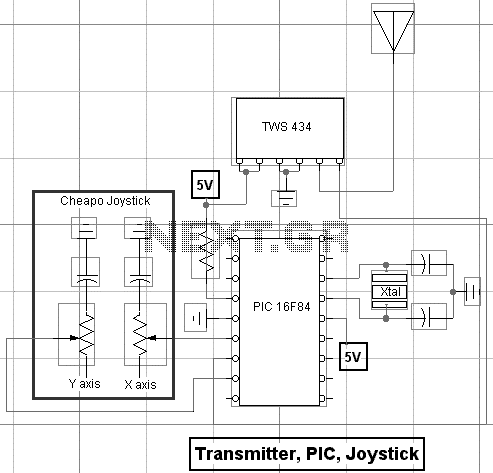
Hextor Hexapod Robot

The circuit includes multiple connections for a BOS (Basic Operating System) processor. It has a serial connection for transmitting data to the BOS processor (pin 0) and receiving data from it (pin 1). Pin 2 is used to supply power to the electronics when set high, while pin 3 can halt current flow when activated. The circuit monitors the busy state of the BOS processor through pin 4, which indicates a high signal when the processor is busy. Pin 5 is designated for infrared communication input, and pin 6 is used for sending data to an LCD display. Pin 7 is for receiving data from the LCD. Pins 8 and 9 control the right green LED and left red LED, respectively, by setting them high. Additionally, pin 14 sends ultrasonic commands, while pin 15 receives ultrasonic data.
The electronic circuit features a comprehensive arrangement of connections tailored for a BOS processor and peripheral devices. The design begins with the serial communication lines, where pin 0 is configured as the transmit (TX) line to send data to the BOS processor, while pin 1 serves as the receive (RX) line for incoming data. This dual-channel communication is essential for effective data exchange between the processor and other components.
Power management is handled through pin 2, which is connected to a power supply. When this pin is set high, it activates the power to the entire electronic system, ensuring that all components receive the necessary voltage to function. Conversely, pin 3 acts as a control line to halt current flow; when activated, it effectively disables the circuit, which can be crucial during debugging or maintenance.
The circuit also incorporates a busy signal indicator via pin 4. This pin is monitored to determine if the BOS processor is currently engaged in processing tasks. A high signal on this pin indicates that the processor is busy, allowing other components to synchronize their operations accordingly.
For communication with infrared devices, pin 5 is utilized as an input for receiving infrared signals. This feature enables the circuit to interact with remote controls or other infrared communication devices. Data transmission to an LCD is facilitated through pin 6, which sends commands or information to the display, while pin 7 is dedicated to receiving feedback or data from the LCD, ensuring a bidirectional communication link.
LED indicators are integrated into the circuit for visual feedback. Pin 8 controls a right green LED, which illuminates when the pin is set high, signaling a positive state or action. Similarly, pin 9 operates a left red LED, providing a contrasting indication. These visual cues are essential for user interaction and system status monitoring.
Lastly, the circuit incorporates ultrasonic communication capabilities. Pin 14 is designated for transmitting ultrasonic commands, while pin 15 is set up to receive incoming ultrasonic data. This functionality enables the circuit to perform distance measurement tasks or object detection, further enhancing its application scope.
Overall, this circuit configuration presents a robust framework for integrating a BOS processor with various peripherals, facilitating effective communication, power management, and user feedback through visual indicators.circuit multiprogs 1 BOS tx con 0 `pin serial to BOS processor 0 BOSrx con 1 `pin serial from BOS processor 4 epower con 2 `pin high turns on power to electronics 2 BOShalt con 3 `pin high halts current BOS move 3 BOSbusy var in4 `pin BOS processor busy => high 5 irrx con 5 `pin infra red comms in, i96n 6 lcdtx con 6 `pin to send to LCD 7 lcdrx con 7 `pin to receive from LCD 8 Rled con 8 `pin high turns on right green led 9 Lled con 9 `pin high turns on left red led outRled var out8 `pin high turns on right green led outLled var out9 `pin high turns on left red led 14 ustx con 14 `pin ultrasonic commands, i96n 15 usrx con 15 `pin ultrasonic data in, i96n 🔗 External reference
The electronic circuit features a comprehensive arrangement of connections tailored for a BOS processor and peripheral devices. The design begins with the serial communication lines, where pin 0 is configured as the transmit (TX) line to send data to the BOS processor, while pin 1 serves as the receive (RX) line for incoming data. This dual-channel communication is essential for effective data exchange between the processor and other components.
Power management is handled through pin 2, which is connected to a power supply. When this pin is set high, it activates the power to the entire electronic system, ensuring that all components receive the necessary voltage to function. Conversely, pin 3 acts as a control line to halt current flow; when activated, it effectively disables the circuit, which can be crucial during debugging or maintenance.
The circuit also incorporates a busy signal indicator via pin 4. This pin is monitored to determine if the BOS processor is currently engaged in processing tasks. A high signal on this pin indicates that the processor is busy, allowing other components to synchronize their operations accordingly.
For communication with infrared devices, pin 5 is utilized as an input for receiving infrared signals. This feature enables the circuit to interact with remote controls or other infrared communication devices. Data transmission to an LCD is facilitated through pin 6, which sends commands or information to the display, while pin 7 is dedicated to receiving feedback or data from the LCD, ensuring a bidirectional communication link.
LED indicators are integrated into the circuit for visual feedback. Pin 8 controls a right green LED, which illuminates when the pin is set high, signaling a positive state or action. Similarly, pin 9 operates a left red LED, providing a contrasting indication. These visual cues are essential for user interaction and system status monitoring.
Lastly, the circuit incorporates ultrasonic communication capabilities. Pin 14 is designated for transmitting ultrasonic commands, while pin 15 is set up to receive incoming ultrasonic data. This functionality enables the circuit to perform distance measurement tasks or object detection, further enhancing its application scope.
Overall, this circuit configuration presents a robust framework for integrating a BOS processor with various peripherals, facilitating effective communication, power management, and user feedback through visual indicators.circuit multiprogs 1 BOS tx con 0 `pin serial to BOS processor 0 BOSrx con 1 `pin serial from BOS processor 4 epower con 2 `pin high turns on power to electronics 2 BOShalt con 3 `pin high halts current BOS move 3 BOSbusy var in4 `pin BOS processor busy => high 5 irrx con 5 `pin infra red comms in, i96n 6 lcdtx con 6 `pin to send to LCD 7 lcdrx con 7 `pin to receive from LCD 8 Rled con 8 `pin high turns on right green led 9 Lled con 9 `pin high turns on left red led outRled var out8 `pin high turns on right green led outLled var out9 `pin high turns on left red led 14 ustx con 14 `pin ultrasonic commands, i96n 15 usrx con 15 `pin ultrasonic data in, i96n 🔗 External reference





